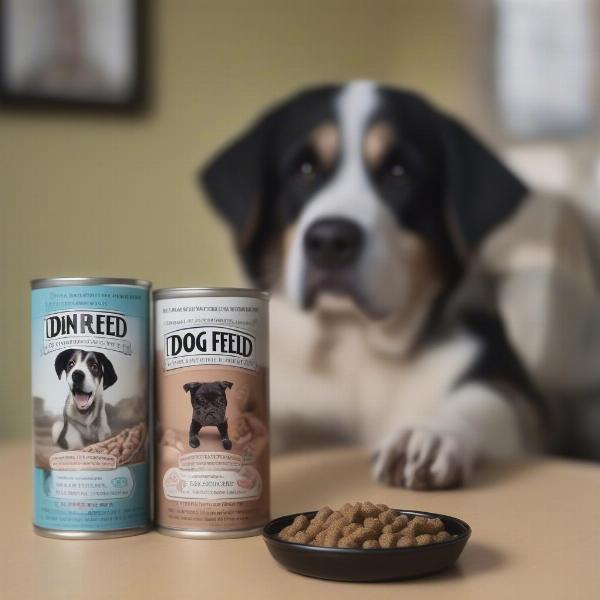Canned dog food is a popular choice for pet owners, offering a convenient and palatable way to provide their furry friends with essential nutrients. But with so many options available, navigating the world of canned dog food can be overwhelming. This guide will delve into the benefits and drawbacks of canned food, discuss important factors to consider when choosing a brand, and provide practical tips for feeding your dog a balanced diet.
Decoding the Canned Dog Food Label
Understanding the information on a canned dog food label is crucial for making informed decisions about your dog’s nutrition. Look for the guaranteed analysis, which lists the minimum percentages of crude protein, fat, fiber, and moisture. The ingredient list, arranged by weight in descending order, reveals the primary components of the food. Pay close attention to the first few ingredients, as they make up the bulk of the product. Look for whole meat sources, like chicken, beef, or lamb, rather than generic terms like “meat by-products.”
Benefits of Canned Dog Food
Canned dog food offers several advantages. Its high moisture content can be beneficial for dogs who don’t drink enough water, helping to prevent dehydration. The palatable texture and aroma often appeal to picky eaters, making mealtimes more enjoyable. Canned food also tends to be higher in protein and fat than dry kibble, providing a concentrated source of energy. Furthermore, the airtight packaging helps preserve nutrients and extends shelf life.
Drawbacks of Canned Dog Food
While canned food has its benefits, there are also some drawbacks to consider. It’s generally more expensive than dry food and can be less convenient to store and serve. Opened cans need to be refrigerated and used within a few days. Canned food can also contribute to dental issues if not complemented with regular teeth cleaning. The higher fat content can be problematic for dogs prone to weight gain or pancreatitis.
Choosing the Right Canned Dog Food for Your Dog
 Dog owner choosing between different canned dog food options
Dog owner choosing between different canned dog food options
Selecting the best canned dog food depends on your dog’s individual needs. Consider factors like age, breed, activity level, and any existing health conditions. Puppies and active dogs require more calories and protein, while senior dogs may benefit from a lower-calorie, higher-fiber diet. Consult with your veterinarian to determine the optimal nutritional profile for your furry companion. They can help you identify specific ingredients to look for or avoid based on your dog’s individual needs. “A balanced diet tailored to your dog’s specific needs is key for optimal health,” says Dr. Emily Carter, DVM, a board-certified veterinary nutritionist.
Feeding Guidelines for Canned Dog Food
Follow the feeding guidelines on the label as a starting point, but adjust the amount based on your dog’s weight, activity level, and body condition. Divide the daily portion into two or more meals to prevent digestive upset. Transitioning to a new canned food should be gradual, mixing increasing amounts of the new food with the old food over several days. “Introducing a new food gradually can help prevent digestive upset and ensure your dog accepts the change,” adds Dr. Carter. You can find high-quality options like nutro canned dog food or victor canned dog food at specialized pet stores.
Conclusion
Canned dog food can be a nutritious and convenient option for many dogs. By understanding the label information, considering your dog’s individual needs, and following proper feeding guidelines, you can help your canine companion thrive on a canned food diet. Choosing the right canned dog food, such as canned dog food salmon or pedigree can dog food, can contribute significantly to your dog’s overall health and wellbeing.
FAQ
-
How long can I store opened canned dog food? Opened canned food should be refrigerated and used within 3-5 days.
-
Can I mix canned and dry dog food? Yes, mixing canned and dry food can provide a balanced diet and cater to picky eaters.
-
Is canned dog food good for all life stages? There are canned food formulations designed for specific life stages, such as puppy, adult, and senior. Choose one that meets your dog’s needs.
-
What should I do if my dog experiences digestive upset after switching to canned food? Transition more gradually, or consult with your veterinarian to determine if a different formula is necessary. royal canin can dog food offers specific formulas for sensitive stomachs.
-
How can I prevent my dog from developing dental issues when feeding canned food? Regular teeth brushing and dental chews can help maintain good oral hygiene.
-
Is canned food a good option for overweight dogs? Choose low-calorie canned food options and monitor your dog’s weight carefully.
-
How do I know if a canned food is high quality? Look for whole meat sources as the first few ingredients and avoid artificial colors, flavors, and preservatives.
ILM Dog is a leading online resource for dog owners worldwide, offering expert advice and practical information on all aspects of dog care, from breed selection and health to training, nutrition, and grooming. We provide comprehensive guides on various topics including dog breeds, health & wellness, training tips, nutrition advice, grooming essentials, and much more. Whether you’re a first-time dog owner or a seasoned expert, ILM Dog is your trusted companion on your dog ownership journey. Contact us at [email protected] or +44 20-3965-8624 for personalized advice.